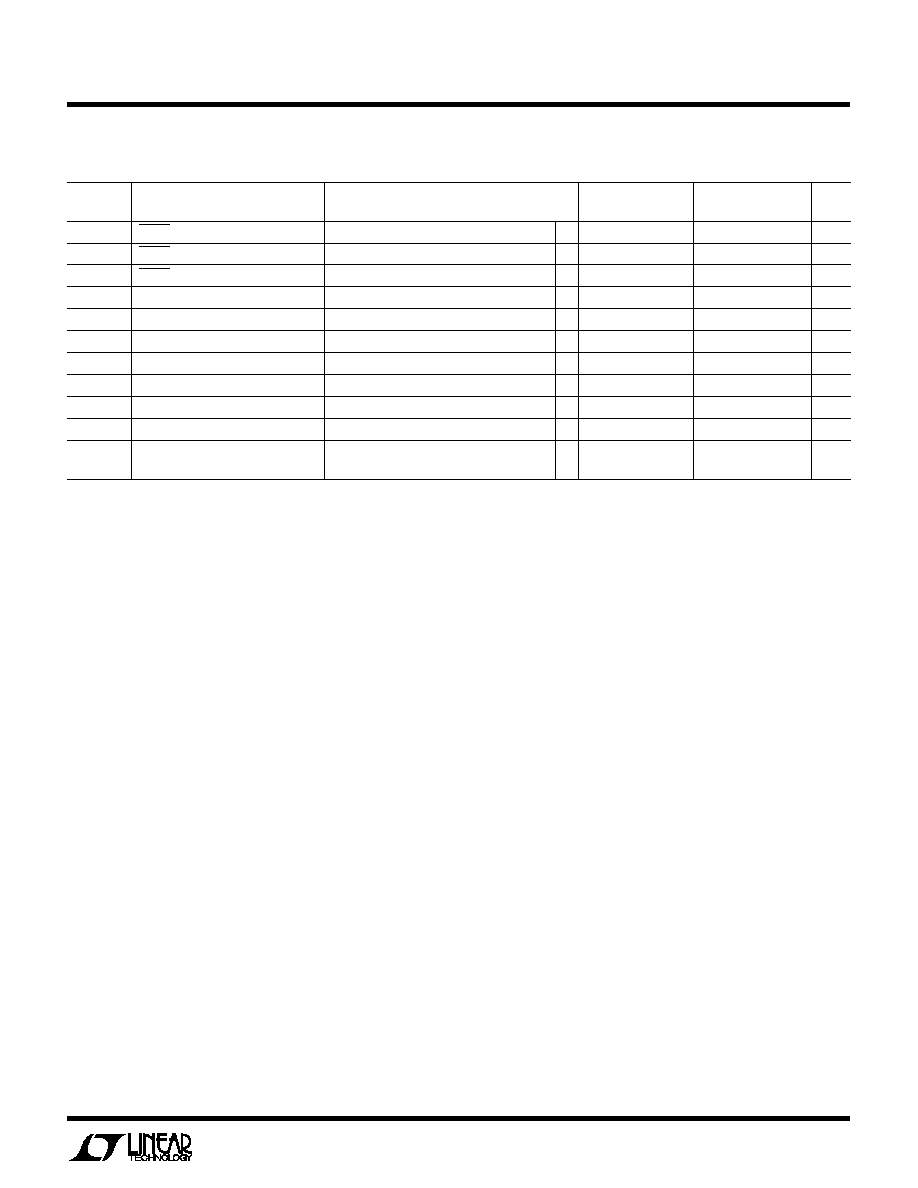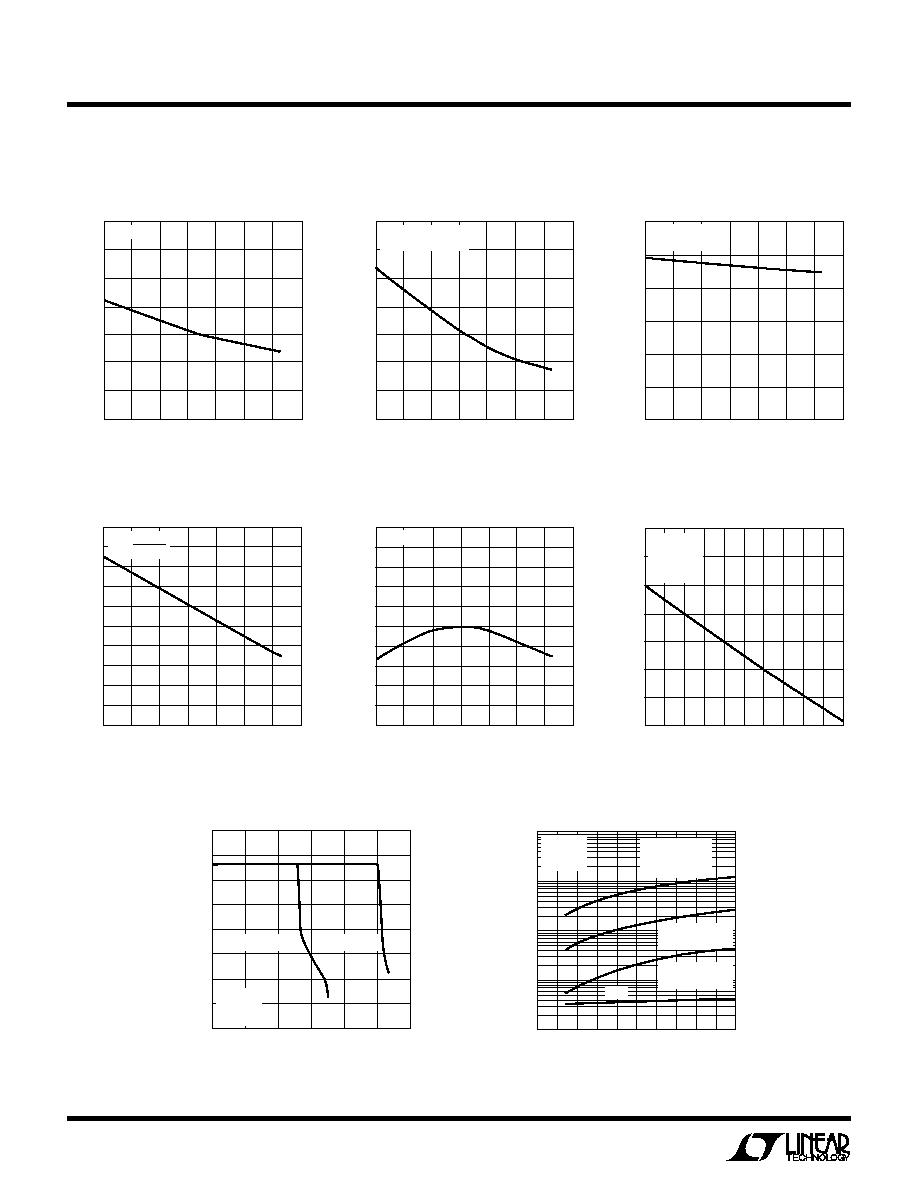Äîêóìåíòàöèÿ è îïèñàíèÿ www.docs.chipfind.ru

1
LTC1430A
High Power Step-Down
Switching Regulator Controller
S
FEATURE
D
U
ESCRIPTIO
The LTC
®
1430A is a high power, high efficiency switching
regulator controller optimized for 5V to 1.xV-3.xV applica-
tions. It includes a precision internal reference and an
internal feedback system that can provide output regula-
tion of
±
1% over temperature, load current and line voltage
shifts. The LTC1430A uses a synchronous switching archi-
tecture with two N-channel output devices, eliminating the
need for a high power, high cost P-channel device. Addi-
tionally, it senses output current across the drain-source
resistance of the upper N-channel FET, providing an
adjustable current limit without an external low value sense
resistor.
The LTC1430A includes a fixed frequency PWM oscillator
for low output ripple under virtually all operating condi-
tions. The 200kHz free-running clock frequency can be
externally adjusted from 100kHz to above 500kHz. The
LTC1430A's maximum duty cycle is typically 93.5% com-
pared to 88% for the LTC1430. This permits 3.3V to 2.xV
conversion using a low power 5V supply. The LTC1430A
features low 350
µ
A quiescent current, allowing greater
than 90% efficiency operation in converter designs from
1A to greater than 50A output current. Shutdown mode
drops the LTC1430A supply current to 1
µ
A.
s
High Power 5V to 1.xV-3.xV Switching Controller:
Can Exceed 10A Output
s
Maximum Duty Cycle > 90% Permits 3.3V to 2.xV
Conversion Using a Low Power 5V Supply
s
All N-Channel External MOSFETs
s
Fixed Frequency Operation--Small L
s
Excellent Output Regulation:
±
1% Over Line, Load
and Temperature Variations
s
High Efficiency: Over 95% Possible
s
No Low Value Sense Resistor Needed
s
Outputs Can Drive External FETs with Up to
10,000pF Gate Capacitance
s
Quiescent Current: 350
µ
A Typ, 1
µ
A in Shutdown
s
Fast Transient Response
s
Adjustable or Fixed 3.3V Output
s
Available in 8-Lead SO and 16-Lead GN
and SO Packages
U
A
O
PPLICATI
TYPICAL
Efficiency
Typical 5V to 3.3V, 10A Application
+
C
IN
220
µ
F
×
4
C
OUT
330
µ
F
×
6
+
+
+
2.7
µ
H/15A
PV
CC1
V
CC
FREQSET
SHDN
COMP
SS
PV
CC2
PGND
GND
G1
I
FB
I
MAX
G2
NC
1430 TA01
SHUTDOWN
FB
NC
Q1A, Q1B, Q2: MOTOROLA MTD20N03HL
C
IN
: AVX-TPSE227M010R0100
C
OUT
: AVX-TPSE337M006R0100
SENSE
+
LTC1430A
SENSE
16k
100
R
C
7.5k
C
C
4700pF
C1
220pF
MBR0530T1
1k
0.1
µ
F
1
µ
F
0.01
µ
F
0.1
µ
F
4.7
µ
F
0.1
µ
F
3.3V
10A
Q1A, Q1B
2 IN PARALLEL
Q2
5V
LOAD CURRENT (A)
40
70
100
90
80
50
60
EFFICIENCY (%)
10
1430 TA02
0.1
1
T
A
= 25
°
C
PV
CC
= 5V
V
OUT
= 3.3V
, LTC and LT are registered trademarks of Linear Technology Corporation.
Pentium is a registered trademark of Intel Corporation.
AMD-K6 is a registered trademark of Advanced Micro Devices, Inc.
U
S
A
O
PPLICATI
s
Power Supply for Pentium
®
II and AMD-K6
®
Microprocessors
s
High Power 5V to 3.xV Regulators
s
Local Regulation for Dual Voltage Logic Boards
s
Low Voltage, High Current Battery Regulation

2
LTC1430A
A
U
G
W
A
W
U
W
A
R
BSOLUTE
XI
TI
S
Supply Voltage
V
CC
....................................................................... 9V
PV
CC1, 2
.............................................................. 13V
Input Voltage
I
FB
......................................................... 0.3V to 18V
All Other Inputs ...................... 0.3V to (V
CC
+ 0.3V)
Junction Temperature ........................................... 150
°
C
Operating Temperature Range
LTC1430AC ............................................. 0
°
C to 70
°
C
LTC1430AI ........................................ 40
°
C to 85
°
C
Storage Temperature Range ................ 65
°
C to 150
°
C
Lead Temperature (Soldering, 10 sec)................. 300
°
C
W
U
U
PACKAGE/ORDER I FOR ATIO
ORDER
PART NUMBER
1
2
3
4
5
6
7
8
TOP VIEW
S PACKAGE
16-LEAD PLASTIC SO
GN PACKAGE
16-LEAD PLASTIC SSOP
16
15
14
13
12
11
10
9
G1
PV
CC1
PGND
GND
SENSE
FB
SENSE
+
SHDN
G2
PV
CC2
V
CC
I
FB
I
MAX
FREQSET
COMP
SS
T
JMAX
= 150
°
C,
JA
= 130
°
C/W (GN)
T
JMAX
= 150
°
C,
JA
= 110
°
C/W (S)
1
2
3
4
8
7
6
5
TOP VIEW
G1
PV
CC1
GND
FB
G2
V
CC
/PV
CC2
COMP
SHDN
S8 PACKAGE
8-LEAD PLASTIC SO
T
JMAX
= 150
°
C,
JA
= 150
°
C/W
S8 PART MARKING
1430A
LTC1430ACS8
LTC1430ACGN
LTC1430AIGN
LTC1430ACS
ORDER
PART NUMBER
Consult factory for Military grade parts.
ELECTRICAL CHARACTERISTICS
LTC1430AC
LTC1430AI
SYMBOL
PARAMETER
CONDITIONS
MIN
TYP
MAX
MIN
TYP
MAX
UNITS
V
CC
Supply Voltage
q
4
8
4
8
V
PV
CC
PV
CC1
, PV
CC2
Voltage
q
3
13
3
13
V
V
OUT
Output Voltage
Figure 1
3.30
3.30
V
V
FB
Feedback Voltage
SENSE
+
and SENSE
Floating ,
q
1.25 1.265 1.28
1.23 1.265 1.29
V
V
COMP
= 2.5V
V
OUT
Output Load Regulation
Figure 1, I
OUT
= 0A to 10A
5
5
mV
Output Line Regulation
Figure 1, V
CC
= 4.75V to 5.25V
1
1
mV
I
VCC
Supply Current (V
CC
Only)
Figure 2, V
SHDN
= V
CC
q
350
700
350
700
µ
A
V
SHDN
= 0V
1
10
1
10
µ
A
I
PVCC
Supply Current (PV
CC
)
Figure 2, PV
CC
= 5V, V
SHDN
= V
CC
(Note 3)
1.5
1.5
mA
V
SHDN
= 0V
0.1
0.1
µ
A
f
OSC
Internal Oscillator Frequency
FREQSET Floating
q
140
200
260
130
200
300
kHz
V
CC
= 5V, T
A
= 25
°
C (Note 2) unless otherwise noted.
(Note 1)

3
LTC1430A
V
CC
= 5V, T
A
= 25
°
C (Note 2) unless otherwise noted.
ELECTRICAL CHARACTERISTICS
LTC1430AC
LTC1430AI
SYMBOL
PARAMETER
CONDITIONS
MIN
TYP
MAX
MIN
TYP
MAX
UNITS
V
IH
SHDN Input High Voltage
q
2.4
2.4
V
V
IL
SHDN Input Low Voltage
q
0.8
0.8
V
I
IN
SHDN Input Current
q
±
0.1
±
1
±
0.1
±
1
µ
A
g
mV
Error Amplifier Transconductance
q
350
650
1100
300
650
1200
µ
mho
g
mI
I
LIM
Amplifier Transconductance
(Note 4)
2400
2400
µ
mho
A
V
Error Amplifier Open-Loop Gain
(Note 5)
q
40
48
40
48
dB
I
MAX
I
MAX
Sink Current
V
I(MAX)
= V
CC
q
8
12
16
8
12
17
µ
A
I
SS
Soft Start Source Current
V
SS
= 0V
q
8
12
16
8
12
17
µ
A
t
r
, t
s
Driver Rise/Fall Time
Figure 3, PV
CC1
= PV
CC2
= 5V
80
250
80
250
ns
t
NOV
Driver Non-Overlap Time
Figure 3, PV
CC1
= PV
CC2
= 5V
25
130
250
25
130
250
ns
DC
MAX
Maximum Duty Cycle
Figure 3, V
COMP
= V
CC
,
q
90
93.5
89
93.5
%
V
FB
= 1.265V
The
q
denotes specifications which apply over the full operating
temperature range.
Note 1: Absolute Maximum Ratings are those values beyond which the life
of a device may be impaired.
Note 2: All currents into device pins are positive; all currents out of device
pins are negative. All voltages are referenced to ground unless otherwise
specified.
Note 3: Supply current in normal operation is dominated by the current
needed to charge and discharge the external FET gates. This will vary with
the LTC1430A operating frequency, operating voltage and the external
FETs used.
Note 4: The I
LIM
amplifier can sink but cannot source current. Under
normal (not current limited) operation, the I
LIM
output current will be zero.
Note 5: The open-loop DC gain and transconductance from the FB pin
(SENSE
+
and SENSE
floating) to COMP pin will be A
V
and gm
V
respectively.

4
LTC1430A
TEMPERATURE (
°
C)
40
12.5
13.0
14.0
20
60
1430 G01
12.0
11.5
20
0
40
80
100
11.0
10.5
13.5
I
MAX
CURRENT (
µ
A)
V
CC
= 5V
TEMPERATURE (
°
C)
40
70
DUTY CYCLE (%)
75
85
90
95
0
40
60
1430 G03
80
20
20
80
100
100
V
COMP
= V
CC
V
FB
= 1.265V
TEMPERATURE (
°
C)
40
210
220
240
20
60
1430 G02
200
190
20
0
40
80
100
180
170
230
OSCILLATOR FREQUENCY (kHz)
V
CC
= 5V
FREQSET FLOATING
Maximum Duty Cycle
vs Temperature
Oscillator Frequency
vs Temperature
Error Amplifier Transconductance
vs Temperature
TEMPERATURE (
°
C)
40
350
TRANSCONDUCTANCE (
µ
mho)
400
500
550
600
850
700
0
40
60
100
1430 G04
450
750
800
650
20
20
80
g
m
=
I
COMP
V
FB
V
FB
vs Temperature
TEMPERATURE (
°
C)
40
V
FB
(mV)
6
8
20
1430 G05
0
6
4
20
0
40
8
10
10
4
2
2
60
80
100
V
CC
= 5V
Load Regulation
LOAD CURRENT (A)
0
1.0
V
OUT
(mV)
0.8
0.4
0.2
0
0.4
1
5
7
1460 G06
0.6
0.2
4
9
10
2
3
6
8
T
A
= 25
°
C
V
OUT
= 3.3V
V
CC
= 5V
FIGURE 4
Supply Current
vs Oscillator Frequency
OSCILLATOR FREQUENCY (kHz)
1
SUPPLY CURRENT (mA)
10
100
1000
0
200
300
400
0.1
100
500
1430 G08
IPV
CC
(LOADED
WITH 10,000pF,
PV
CC
= 12V)
IPV
CC
(NO LOAD,
PV
CC
= 5V)
IPV
CC
(NO LOAD,
PV
CC
= 12V)
IV
CC
T
A
= 25
°
C
V
CC
= 5V
FIGURE 4
Output Voltage vs Load Current
with Current Limit
LOAD CURRENT (A)
0
OUTPUT VOLTAGE (V)
1.5
2.0
2.5
6
10
1430 G07
1.0
0.5
0
2
4
8
3.0
3.5
4.0
12
T
A
= 25
°
C
V
CC
= 5V
FIGURE 4
R
I(MAX)
= 10k
R
I(MAX)
= 16k
TYPICAL PERFOR A CE CHARACTERISTICS
U
W
I
MAX
Pin Sink Current
vs Temperature

5
LTC1430A
COMP (Pin 10/Pin 6): External Compensation. The COMP
pin is connected directly to the output of the error amplifier
and the input of the PWM. An RC network is used at this
node to compensate the feedback loop to provide opti-
mum transient response. See Applications Information for
compensation details.
FREQSET (Pin 11/NA): Frequency Set. This pin is used to
set the free running frequency of the internal oscillator.
With the pin floating, the oscillator runs at about 200kHz.
A resistor from FREQSET to ground will speed up the
oscillator; a resistor to V
CC
will slow it down. See Applica-
tions Information for resistor selection details.
I
MAX
(Pin 12/NA): Current Limit Set. I
MAX
sets the thresh-
old for the internal current limit comparator. If I
FB
drops
below I
MAX
with G1 on, the LTC1430A will go into current
limit. I
MAX
has a 12
µ
A pull-down to GND. It can be adjusted
with an external resistor to PV
CC
or an external voltage
source.
I
FB
(Pin 13/NA): Current Limit Sense. Connect to the
switched node at the source of Q1 and the drain of Q2
through a 1k resistor. The 1k resistor is required to prevent
voltage transients from damaging I
FB
. This pin can be
taken up to 18V above GND without damage.
V
CC
(Pin 14/Pin 7): Power Supply. All low power internal
circuits draw their supply from this pin. Connect to a clean
power supply, separate from the main PV
CC
supply at the
drain of Q1. This pin requires a 4.7
µ
F or greater bypass
capacitor. 8-lead parts have V
CC
and PV
CC2
tied together
at Pin 7 and require at least a 10
µ
F bypass to GND.
PV
CC2
(Pin 15/Pin 7): Power V
CC
for Driver 2. This is the
power supply input for G2. G2 will swing from GND to
PV
CC2
. PV
CC2
is usually connected to the main high power
supply. 8-lead parts have V
CC
and PV
CC2
tied together at
Pin 7 and require at least a 10
µ
F bypass to GND.
G2 (Pin 16/Pin 8): Driver Output 2. Connect this pin to the
gate of the lower N-channel MOSFET, Q2. This output will
swing from PV
CC2
to PGND. It will always be low when G1
is high.
PI FU CTIO S
U
U
U
G1 (Pin 1/Pin 1): Driver Output 1. Connect this pin to the
gate of the upper N-channel MOSFET, Q1. This output will
swing from PV
CC1
to PGND. It will always be low when G2
is high.
PV
CC1
(Pin 2/Pin 2): Power V
CC
for Driver 1. This is the
power supply input for G1. G1 will swing from PGND to
PV
CC1
. PV
CC1
must be connected to a potential of at least
PV
CC
+ V
GS(ON)
(Q1). This potential can be generated using
an external supply or a simple charge pump connected to
the switching node between the upper MOSFET and the
lower MOSFET; see Applications Information for details.
PGND (Pin 3/Pin 3): Power Ground. Both drivers return to
this pin. It should be connected to a low impedance ground
in close proximity to the source of Q2. 8-lead parts have
PGND and GND tied together at Pin 3.
GND (Pin 4/Pin 3): Signal Ground. All low power internal
circuitry returns to this pin. To minimize regulation errors
due to ground currents, GND should be connected to
PGND right at the LTC1430A. 8-lead parts have PGND and
GND tied together internally at Pin 3.
SENSE
, FB, SENSE
+
(Pins 5, 6, 7/Pin 4): These three
pins connect to the internal resistor divider and to the
internal feedback node. To use the internal divider to set
the output voltage to 3.3V, connect SENSE
+
to the positive
terminal of the output capacitor and SENSE
to GND. FB
should be left floating in applications that use the internal
divider. To use an external resistor divider to set the output
voltage, float SENSE
+
and SENSE
and connect the exter-
nal resistor divider to FB.
SHDN (Pin 8/Pin 5): Shutdown. A TTL compatible low
level at SHDN for longer than 50
µ
s puts the LTC1430A into
shutdown mode. In shutdown, G1 and G2 go low, all
internal circuits are disabled and the quiescent current
drops to 10
µ
A max. A TTL compatible high level at SHDN
allows the part to operate normally.
SS (Pin 9/NA): Soft Start. The SS pin allows an external
capacitor to be connected to implement a soft start func-
tion. An external capacitor from SS to ground controls the
start-up time and also compensates the current limit loop,
allowing the LTC1430A to enter and exit current limit
cleanly. See Applications Information for more details.
(16-Lead Package/8-Lead Package)




